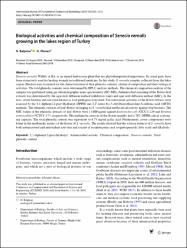Biological activities and chemical composition of Senecio vernalis growing in the lakes region of Turkey
Abstract
Senecio vernalis Waldst. et Kit. is an annual herbaceous plant that has phytotherapeutical importance. Its aerial parts have been extensively used for healing wounds in traditional medicine. In this study, S. vernalis samples collected from the lakes region (Burdur) were examined for the characterization of their phenolic contents, chemical composition and their biological activities. The total phenolic contents were determined by HPLC analysis methods. The chemical composition analysis of the samples was performed using gas chromatography-mass spectrometry (GC-MS). Antimicrobial screening of the flower-leaf extracts was determined by the agar disk diffusion method (inhibition zone) and agar well diffusion method (MIC). In the tests, seven bacteria and one yeast known as food pathogens were used. The antioxidant activities of the flower extracts were assessed by the 1,1-diphenyl-2-picrylhydrazyl (DPPH) and 2,2 '-azino-bis-3-ethylbenzothiazoline-6-sulfonic acid (ABTS) methods. The ethanolic extracts of leaf-flower belonging to S. vernalis had antibacterial activity against four bacteria. The MIC values of the ethanolic extracts of leaf-flower were 13,000 mu g/ml against Escherichia coli ATCC11229 and Yersinia enterocolitica NCTC11174, respectively. The methanolic extracts of the flower samples had a 78% DPPH radical scavenging capacity. The total phenolic content was equivalent to 4.73 mg/ml gallic acid. Furthermore, seven components were found in the methanolic extract of the leaves of S. vernalis. The results showed that the various extracts of S. vernalis have both antimicrobial and antioxidant activities and consist of sesquiterpenes and sesquiterpenoids, fatty acids and alkaloids.


















